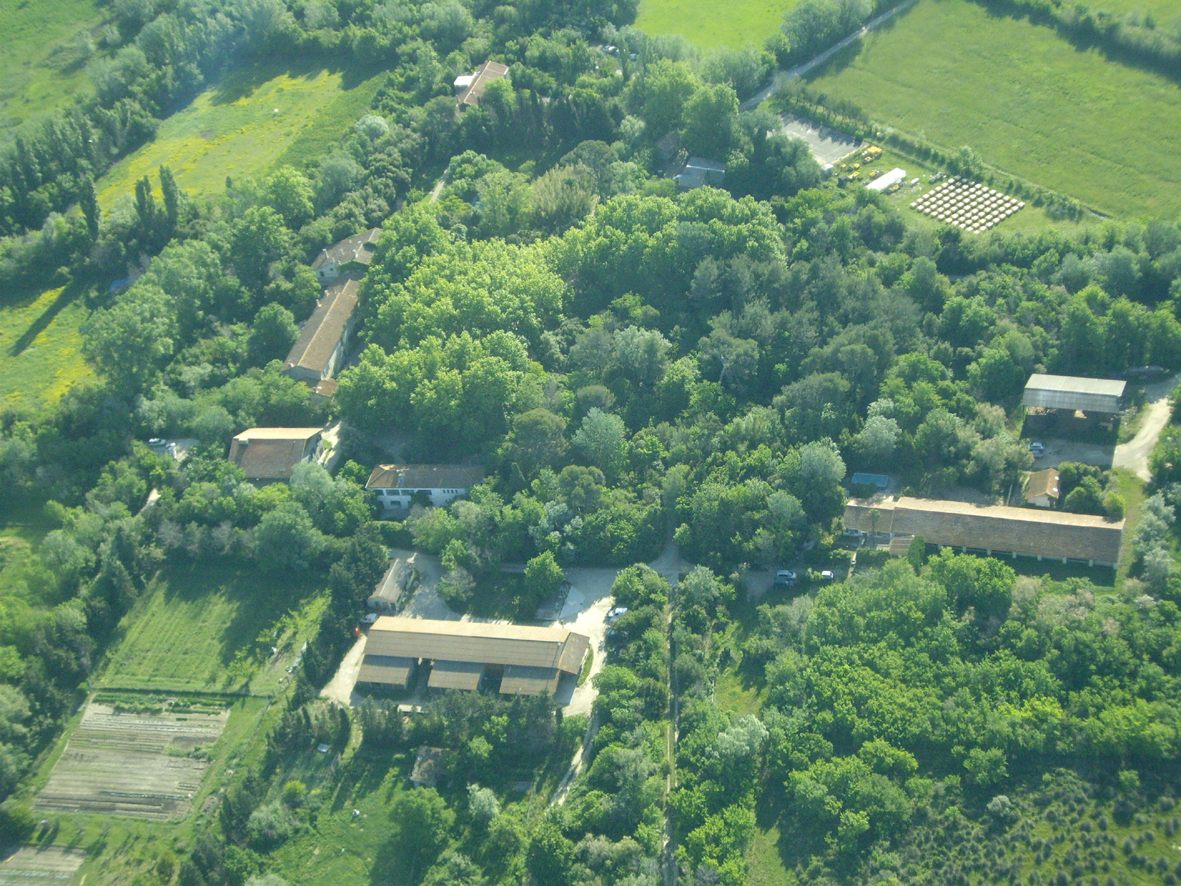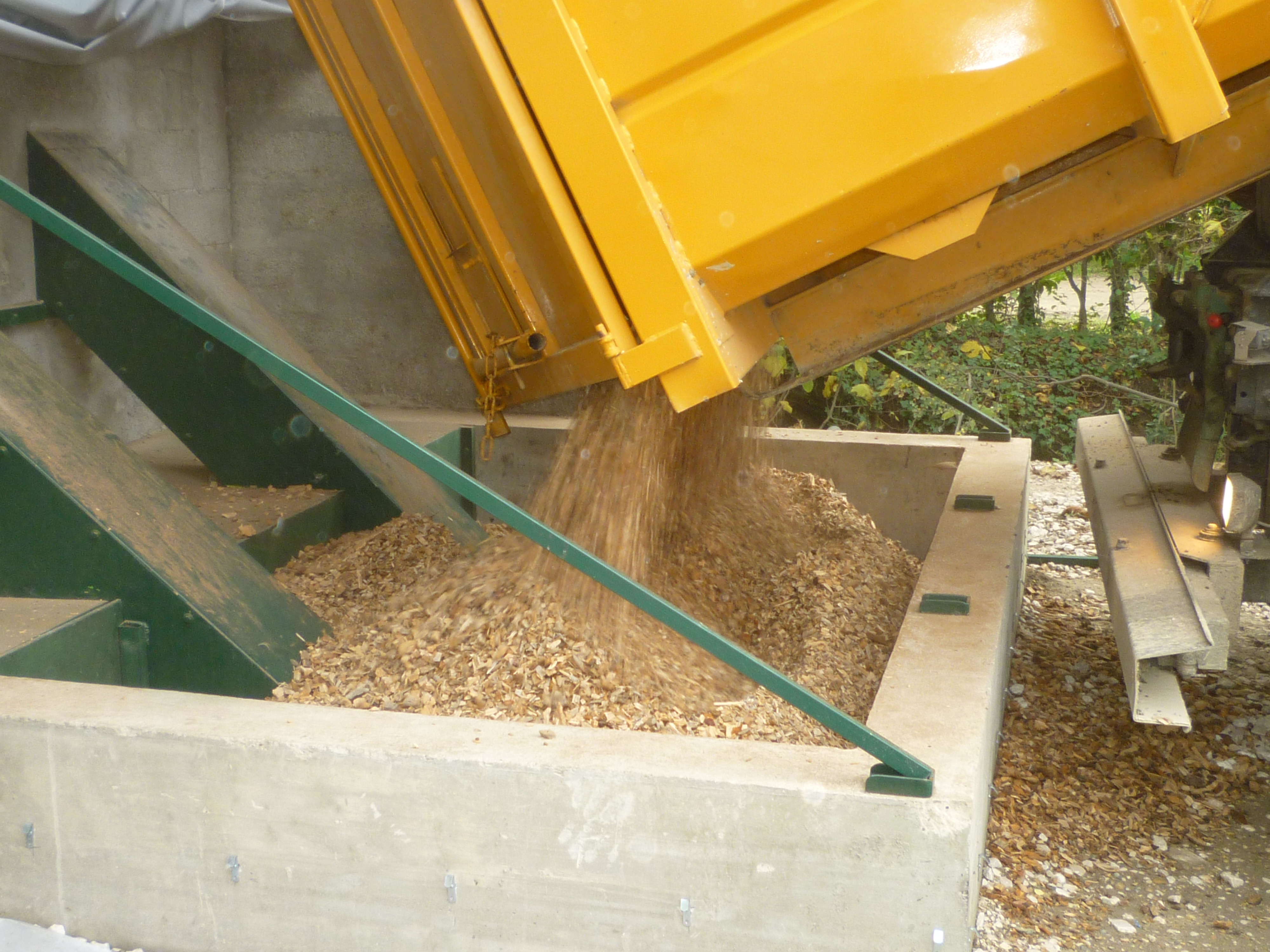Consistent with being a research centre for the conservation of Mediterranean wetlands, the Tour du Valat is also concerned about minimising its impacts on the natural environment. That is why, over the last few years, it has developed a veritable environmental management strategy, developed in three areas:
- Improving the treatment of its waste (sorting, reed bed domestic wastewater treatment plant;
- Drawing up a policy for reducing the impacts of local and international transport;
- Renovating its buildings in the Camargue to improve their energy efficiency.

The Tour du Valat buildings, in the heart of the Camargue
Objective: Factor 4
It is in the framework of this third area that the Tour du Valat committed itself in 2008 to an ambitious work programme: reducing the energy consumption of its buildings and its CO2 emissions by 400%! A challenge that was far from easy to achieve due to the configuration of the premises: more than 3000 m2 of floor space in eight buildings dating from the mid-19th century to the 1950s, spread over several hectares, and originally heated by eight gas or oil-fired boilers.
Nourished by the experience of the Life Promesse project (see here opposite) carried out at another Camargue site involved in an innovative renovation programme, the Vigueirat Marshes, in 2008 the Tour du Valat started by performing an energy diagnosis of all its facilities and buildings.
The result was a heating energy consumption of nearly 200 kWh/m2/year, with 168 tons/year of CO2 emitted.
The Tour du Valat then developed an energy strategy based on the principles of the ‘negaWatt’ approach:
- Energy sobriety (investing in more efficient appliances to limit its requirements, and encouraging energy-saving behaviour);
- Energy performance (reducing consumption through optimised insulation of its buildings);
- Renewable energy (satisfying a maximum of needs using renewable energy sources by setting up a central boiler fired by local biomass, and solar water heaters to produce hot water);
- Local relevance (developing solutions that use sources of biomass produced on the site or nearby, and appropriate to the geographically dispersed Camargue habitat).
The implementation of these solutions was then carried out between 2009 and 2013, thanks to considerable financial support from:
- Regional environment and energy funding (FREE, State-Region-ADEME framework agreement, 2009-2013);
- The European Regional Development Fund operational programme for the Provence-Alpes-Côte d’Azur Region;
- The local energy-environment plan backed by the Camargue Regional Natural Park.
The buildings were renovated using a three-pronged approach:
- Improving the energy performance of the building through appropriate insulation (cellulose insulation of all the attic space), reinforcing the insulation of the northern external facades of the ‘Mas’ and ‘Château’ using rice straw, and replacing the windows to improve insulation;
- Heating by means of a multi-fuel biomass boiler. This facility now enables us to use and develop local renewable energy sources (wood chips and rice hulls) for heating;
- Producing hot running water using solar energy, by means of four solar water heaters above the accommodation and canteen.

Thermal insulation from outside of the farmhouse’s north side with rice straw in 2013
A very positive outcome
The final outcome of the renovation proved to be very positive.
In terms of thermal efficiency, the Tour du Valat’s consumption for heating went from 196 kWh/yr/m² before the works (average 2006-2009) to 61 kWh/yr/m² for the winter of 2013-2014, i.e. a saving of 69%. If we compare the results for identical climatic conditions, the outcome remains very favourable, with a saving of 48%.
Concerning the economic assessment (carried out only for the buildings using the heating network, i.e. 90% of the Tour du Valat’s total heating consumption), the estimated gain since the boiler was set up is €88,000 , i.e. €22,000 per year on average, for a total investment cost of €907,000 including VAT. On the basis of these initial results, the estimated return-on-investment time (excluding public grants) for the boiler and heating network is 20 years, or 39 years if we factor in the investment made for insulation. After deducting all public grants, the return-on-investment time should be about 18 years. However, the inclusion in these calculations of the fuel oil that had to be used for two heating seasons due to incidents that occurred with the boiler, plus the fact that the insulation work was not finalised until year 3, mean that the savings should increase once the system is fully operational, with a consequent decrease in the return-on-investment time.
The environmental analysis is also encouraging because the use of biomass (forestry chippings) as fuel caused CO2 emissions to drop by 87% between 2009 and 2014, i.e. a result significantly better than the objective. Concerning nitrogen oxides (NOX), although weight-for-weight wood produces more of them than fuel oil, emissions were reduced by more than 25% due to the drastic reduction in fuel consumption.

Supplying of the main heater with wood chips
Promising results to be improved
This renovation work enabled the Tour du Valat to:
- Halve its energy consumption. This is a convincing result, but still a long way from the initial objective of reducing consumption by three quarters
- Divide CO2 emissions by 6 (reduction of 87%), thus exceeding the initial objective;
- Divide heating costs by 3 (reduction of 70%). This major saving, resulting from the decrease in energy consumption and the use of forestry chippings instead of fossil fuels, should be further improved once we can burn rice hulls from the Camargue;
- Save €22,000 per year, on average.
The keys to success: unfailing desire and setting up monitoring indicators
Above and beyond the figures, launching such a process requires unfailing desire by the project owner. In particular, it is essential to have a specialist project manager and a workforce skilled in the fields concerned. An assistant project manager can also be very useful. Internal communication is also required in order to fully inform colleagues, raise their awareness, and encourage energy-saving behaviour. Getting all the colleagues to adopt energy-sobriety, and assisting them in the process, is a major workload on a daily basis. Yet that aspect must not be neglected, because it is a precondition for the acceptance of the renovation undertaken, together with the performances of the facilities. And we were able to observe that, even in an organisation working in the environmental sector, it can take a long time for people to change their way of thinking!
The setting up of measuring (calories, water, temperature, etc.) and monitoring systems is indispensable for obtaining a continuous assessment of the facilities’ performances, and the savings achieved. It also makes it easier subsequently to transfer experience to other organisations interested in conducting such projects.
Obstacles encountered
While the overall assessment was largely positive, the renovation programme carried out at the Tour du Valat in the last few years ran into some obstacles during its implementation. In particular, we can mention:
- The limits of a renovation project: this type of project is often more difficult to set up than in the case of a new construction because it is not possible to use the full range of technical possibilities now available. In addition, and for the same reason, the work phases proved very restrictive due to the continuous occupation of the buildings and the length of time the work took.
- The trial and error inherent in a pilot project: using unusual local materials (such as rice hulls) and testing a certain number of innovative techniques (for example insulating with rice straw) required additional adaptation time, or even modification after they have been put in place. In addition, at present few building professionals are trained and skilled in innovative techniques, either locally or nationally. However, we can wager that this surplus time devoted to tests and carrying out the work will not be lost, and that we will be able to make use of it in future visits and experience sharing with other organisations interested in carrying out such projects.
Medium and long-term perspectives
Although the operational set-up phase is now over, the Tour du Valat does not consider the works programme to be finished. Three objectives have been set for the next few years:
- Continuing to improve the performances of the facilities: compared to these preliminary results, the insulation work finalised in winter 2013-2014 (changing of windows), the replacement of forestry chippings by rice hulls, and work on user behaviour should enable significant improvement in energy performances for upcoming heating seasons;
- Developing our resources: the new partnership concluded with the Caisse d’Épargne Provence-Alpes-Corse bank, has enabled us to acquire a grinder to convert some of the Tour du Valat’s wood into heating chips. Another facet of this partnership will be the setting up of a system for extracting and storing rice hull ash to be used as fuel.
- Sharing our experience: despite the setbacks mentioned, it is highly motivating to put in place this type of innovative project, and to measure its benefits very quickly. It is also very stimulating to say that in the end these trial works were carried out reasonably fast, with convincing concrete results. It is now up to the Tour du Valat to spread the word and transfer the results. Several public and private sector organisations interested in conducting such projects have already contacted us, and several work site visits and exchanges have taken place. We will obviously continue to work in that direction to encourage the development of more projects like this one.